
Great Moments in Black History #12: Deebo Got It From His Mama
June 1st, 2009 Posted by david brothers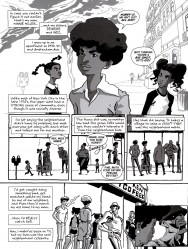
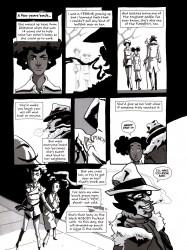
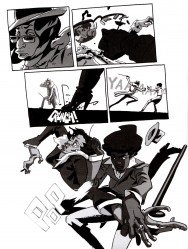
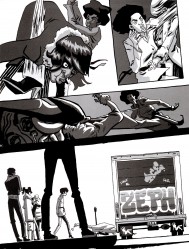
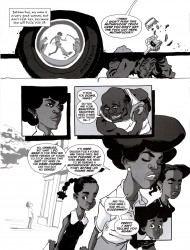
from vertigo’s sentences, words by percy “mf grimm” carey, art by ron wimberly
(word to cheryl lynn)







Lone Wolf and Cub volume 2: The Gateless Barrier
Writer: Kazuo Koike
Artist: Goseki Kojima
Publisher: Dark Horse Comics
ISBN: 1569715033
304 pages
I completely missed this last time around, but so far, the titles of each volume of Lone Wolf & Cub are very specific references to events in the book. The Assassin’s Road, obviously, is the path that Ogami and Daigoro walk. It’s filled with senseless slaughter and cruelty, and leads directly to meifumado, the Buddhist hell and home to demons and damnation. The Gateless Barrier, as explained in this volume, is mumon-seki, walking alone between heaven and earth. The assassin’s road is all there is, and nothing exists outside of it. You become mumon-seki of the assassin’s road.


 Ogami remains just as invulnerable as he was in the first volume. The first story, “Red Cat,” features a tale that should be familiar to fans of The Punisher. Ogami allows himself to be captured and taken to jail to fulfill a job. When he gets there, he’s hassled by the prisoners. They sing a song to intimidate him (no, really). When that doesn’t work, they attack him. Just as in “Wings to the Birds, Fangs to the Beasts” in the last volume, he doesn’t even acknowledge their existence. He takes the beating, not even bothering to grunt. This just pisses them off more. When he finally speaks, it’s to ask where a man is. Once he finds out that the man is on death row, Ogami murders a lot of them. The guards come and he’s taken to death row, to be executed tomorrow with his target.
Ogami remains just as invulnerable as he was in the first volume. The first story, “Red Cat,” features a tale that should be familiar to fans of The Punisher. Ogami allows himself to be captured and taken to jail to fulfill a job. When he gets there, he’s hassled by the prisoners. They sing a song to intimidate him (no, really). When that doesn’t work, they attack him. Just as in “Wings to the Birds, Fangs to the Beasts” in the last volume, he doesn’t even acknowledge their existence. He takes the beating, not even bothering to grunt. This just pisses them off more. When he finally speaks, it’s to ask where a man is. Once he finds out that the man is on death row, Ogami murders a lot of them. The guards come and he’s taken to death row, to be executed tomorrow with his target.
He finds his man on death row, and they speak briefly. The target is an arsonist, and indirectly caused the death of the warden of the prison. Last time he was arrested, he’d started a fire in his cell, forcing the prison to evacuate. Rather than returning to jail after being temporarily freed, he ran. The warden took his own life out of shame.




After that, though, we get right into the child abuse.
Read the rest of this entry �


For the past couple years, I’d take a second every once and a while to talk about CHIKARA, an indy wrestling organization based out of Philadelphia. Founded by wrestler and head trainer Mike Quackenbush, it’s a school that turned into its own federation. With seven years under its belt, it’s grown to have its own cult following and for good reason.
I regularly bring guests to their shows, tending to take those along who know little or nothing to do with wrestling. They always have a blast. Where else can you see a mute sea monster in a muscle suit team up with a amateur wrestling Rocky Balboa against two clown-like figures dressed up like ice cream people? And not only that, but the wrestling is actually GOOD! It’s routinely funny and the storytelling is top notch.
Back when I first got into it, I did a post about how a bunch of the DVD covers are homages to notable comic book covers. As time went on, the article became a bit popular, but I lost track after a while and kept putting off an update. Now, I think it’s time not to pick up from after I left off, but to redo it from beginning to end. Here we go!
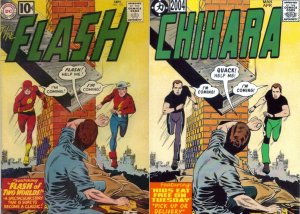
Kids Eat Free On Tuesday & Pick Up Or Delivery
Based on: Flash #123
Features: Mike Quackenbush… and Mike Quackenbush

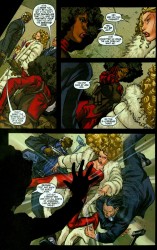
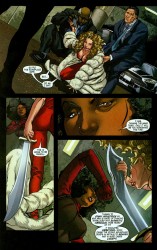
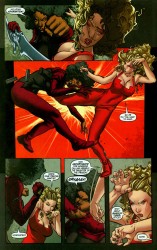
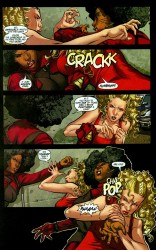
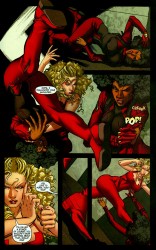
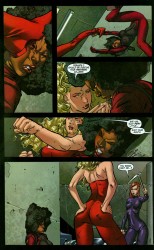
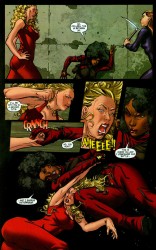
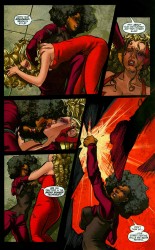

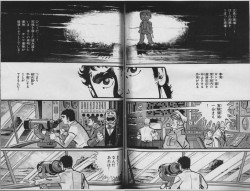
Garret sent over the link to a full scan of Hulk and thanked me for visiting his site. And, wow! It’s really interesting to see. I bothered a few Japanese-speaking friends until they agreed to help me figure out a few of details. The katakana for the title reads “Haruku.” Later in the volume, the logo treatment changes so that it reads “Haruku: Monsutaa Komiku.” “Hulk: Monster Comic.”
From what I and my lovely assistants managed to figure out of the story, it stars Dr. Araki, survivor of Hiroshima. Both of his parents died in the blast, and he’s come to Nevada to work on the gamma bomb. General Ross, Major Talbot, and Igor retain their names, but Rick Jones has been turned into Ricky Tenda. He’s got a Japanese mom and an American dad. Betty Ross is now Mitsuko, though Dr. Araki calls her Mitchan.
Read the rest of this entry �

No idea, but Gav told me to do this.
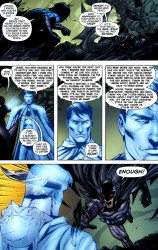
From the ever-classic rap battle.












Lone Wolf and Cub volume 1: The Assassin’s Road
Writer: Kazuo Koike
Artist: Goseki Kojima
Publisher: Dark Horse Comics
ISBN: 1569715025
296 pages
Before I get into talking about the book, I want to take a moment and compliment the translation team for Lone Wolf & Cub. Dana Lewis is credited with “translation,” and a brief google search reveals that Lewis is/was a part of Studio Proteus, one of the main forces that helped bring manga into the mainstream here in the States.
The translation is an adaptation, rather than a word-for-word find/replace job. It takes into account that certain things simply can’t be translated into English or American culture, and adjusts accordingly. Specific terms are often left in their original Japanese, and a combination of context and a solid glossary at the back help to explain what’s going on. There are also a few moments of re-contextualization in the text. One chapter ends with a woman looking on at Ogami and Daigoro as they cross a river. She says, “A baby carriage… on the river Sanzu.” The Sanzu River means nothing to most American readers, but the title of the chapter, “Baby Cart on the River Styx” provides a context clue. While the river Styx isn’t 100% the same as the river Sanzu, the basic idea is the same. The father and son are both caught on the path of the doomed and the dead. It’s an idea that’s repeated fairly often throughout the book, both from Ogami’s mouth and those of the people he encounters.
I knew many of the broad strokes going in due to a passing interest in Japanese history. Iga and Koga ninja, the Yagyu clan, Tokugawa shogunate, and a fistful of other terms will be familiar to anyone who has spent any amount of time partaking in anything that involves samurai or ninjas, from history books to manga to anime.
Japanese history tends to pop up everywhere in their pop culture. Amakusa Shiro is a popular villain in anime and video games, most notably Samurai Shodown. Yagyu Jubei has been presented more than once as the samurai equivalent of Marvel’s Nick Fury, from the eyepatch down to the war hero status and career as a spy. I don’t know that American culture can really compare. I’ve seen very little popular fiction starring George Washington or Benjamin Franklin, and I don’t think any of it has resulted in the same penetration that Japanese historical figures have. It’s fascinating.
Lone Wolf and Cub: The Assassin’s Road contains nine stories. “Son for Hire, Sword for Hire,” “A Father Knows His Child’s Heart, as Only a Child Can Know His Father’s,” From North to South, From West to East,” “Baby Cart on the River Styx,” “Suio School Zanbato,” “Waiting for the Rains,” “Eight Gates of Deceit,” “Wings to the Birds, Fangs to the Beast,” and “The Assassin’s Road” make up just a hair under 300 pages of samurai action.
Read the rest of this entry �

Last time on We Care a Lot, I covered the last days of Venom’s solo series. In my last few articles, I totally forgot to cover an obscure comic dedicated to him by the name of Uncanny Origins #7. Uncanny Origins was a somewhat short-lived series where each issue went into the backstory of a random Marvel character, featuring cartoony art by Dave Hoover. Each issue cost only a dollar, so you can’t really hate on it too much.
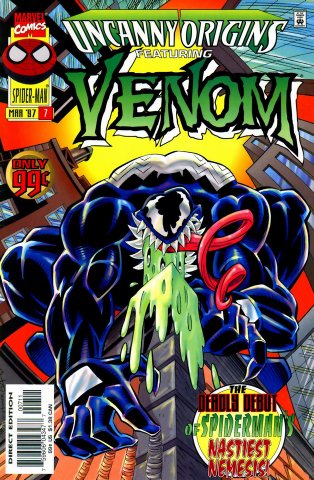
Bob Budiansky writes through Venom’s origins and story up to his Lethal Protector days.
“He thinks of himself as a superhero – dedicated to defending the innocent from evildoers everywhere. But the reality is that he is a grotesque parody of everything he believes himself to be, a superhero in his mind and his mind alone… for no good deed he does in the present can ever erase the evil of his own wretched past!”
Aw, come on. Don’t be so pessimistic.
The opening couple pages are interesting in that they’re new to us. We see Eddie Brock, smarmy as hell, visiting his ex-wife at a restaurant. He’s pretty high on himself for his successful Sin-Eater stories, but that just pisses off Ann and makes her leave less than a minute into their meeting. Everything always has to be about Eddie. Eddie defends himself, claiming that he’s doing the public a service with honest reporting, but she won’t listen.
Then we see Eddie being called to work and the subsequent firing. From there, it shows the events of his first appearance from his side. After his initial defeat, we get a montage page about how he has lost to Spider-Man again and again, until it gets into how Venom is out to be a good guy. It recreates the events where Ann gets Venom to leave Spider-Man alone and that’s the end of the issue.
I do like how Budiansky helps bring a little understanding to Eddie’s rage by showing another reason the Sin-Eater situation has ruined his life.

Whoa, whoa, whoa! What’s this about girls on girls?
Enough of that. Let’s get to the real article.
